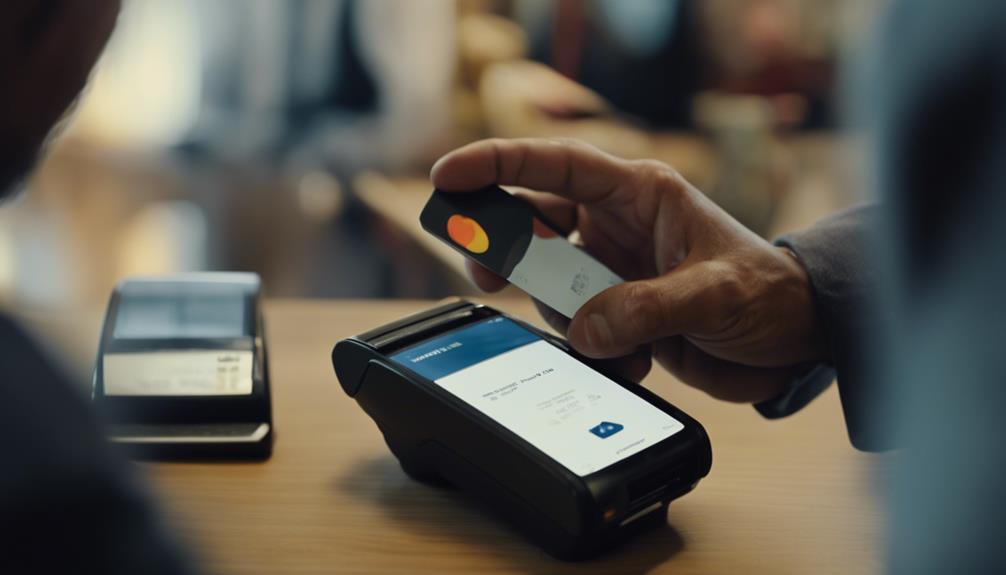To secure mobile payments as a merchant, guarantee compliance with industry standards like PCI DSS for handling payment data securely. Implement robust encryption and multi-factor authentication to protect sensitive information and prevent unauthorized access. Regularly update security protocols to address vulnerabilities and protect customer data. Monitor transactions for unusual activities and fraud attempts, analyzing spending behavior to swiftly spot irregularities. Utilize tokenization to reduce data breach risks during transactions. Invest in fraud detection tools using advanced algorithms to enhance security measures. Build customer trust by communicating security measures transparently and addressing feedback promptly. Implementing these practices is essential for safeguarding data, preventing fraud, and gaining customer trust.
Key Takeaways
- Compliance with PCI DSS standards for secure payment handling.
- Implement encryption and multi-factor authentication for data protection.
- Regular security protocol updates to address vulnerabilities promptly.
- Utilize transaction monitoring to detect and prevent fraud.
- Implement tokenization to reduce data breach risks during transactions.
Compliance With Industry Standards

To guarantee secure handling of payment data, compliance with industry standards like PCI DSS is vital. Payment data, especially when processed through mobile devices, is highly vulnerable to security breaches. Adhering to PCI DSS and other industry standards not only protects sensitive information but also guarantees that regulatory requirements are met, building trust with customers and avoiding potential penalties.
Non-compliance can lead to financial losses and damage to your reputation as a merchant. By following security protocols and maintaining compliance, you reduce the risk of data breaches and enhance the overall security posture of your payment processing system. Embracing these standards is essential in safeguarding both your business and your customers from potential threats in the ever-evolving landscape of mobile payments.
Stay proactive in implementing these measures to stay ahead of potential risks and protect the integrity of your payment operations.
Encryption and Multi-Factor Authentication

Enhancing mobile payment security involves implementing robust encryption and multi-factor authentication measures to protect sensitive data and prevent unauthorized access. Encryption plays a vital role in mobile payments by converting sensitive information into unreadable code, ensuring secure data transmission and storage. This data encryption process thwarts interception attempts and deters cybercriminals from accessing confidential details during transactions.
Additionally, multi-factor authentication strengthens security by requiring users to provide multiple forms of verification, such as passwords and biometrics. By incorporating these authentication methods, secure mobile payment systems adhere to industry standards like PCI DSS, safeguarding transactions and customer information effectively.
The complexity of encryption in mobile payment processing acts as a barrier against unauthorized access, adding an extra layer of defense against potential security breaches. With multi-factor authentication, users must confirm their identity through various verification methods, enhancing transaction security and bolstering overall cybersecurity in the mobile payments landscape.
Regular Security Protocol Updates

Regular security protocol updates are essential for keeping your mobile payment system secure. By ensuring timely software updates and continuous security monitoring, you can protect against new threats and vulnerabilities.
Staying proactive in updating these protocols helps maintain compliance with industry standards and safeguards against breaches.
Timely Software Updates
Prioritizing timely software updates is crucial for maintaining the security of mobile payment systems. Regular updates help address vulnerabilities and patch security flaws, safeguarding sensitive customer data and mobile payment revenue.
By staying current with security patches, merchants can protect their platforms against cyber threats and ensure secure transactions. Updated security protocols play an important role in enhancing the defense mechanisms of mobile payment systems, shielding them from evolving risks in the digital landscape.
It's imperative for merchants to schedule and prioritize these software updates to uphold the integrity and security of their payment processes. Neglecting these updates can leave systems vulnerable to attacks, potentially leading to data breaches and financial losses.
Continuous Security Monitoring
To maintain the security of mobile payment systems, continuous security monitoring through regular updates of security protocols is crucial. By staying vigilant and updating security measures, merchants can prevent card fraud, protect customer information, and guarantee secure authentication in online and digital payment processing.
Continuous monitoring helps to detect and address any vulnerabilities in the system promptly, enhancing Mobile Payment Security. Regular updates also guarantee compliance with industry standards and regulations, fostering trust among customers.
Monitoring Transaction Patterns
Monitoring transaction patterns is essential for detecting unusual activities and fraud attempts in real-time.
By analyzing spending behavior and transaction data, you can identify trends, anomalies, and potential security threats swiftly.
Tracking these patterns enables you to spot irregularities and take immediate action to protect sensitive information and enhance security measures.
Detecting Unusual Activities
By analyzing transaction data, you can effectively detect unusual activities such as sudden spikes in transactions, helping you identify potential fraudulent behavior or abnormal spending patterns. Monitoring transaction patterns allows you to flag irregularities in customer behavior that could indicate fraudulent activities or security breaches.
Implementing automated systems to monitor these patterns enables you to proactively detect and prevent suspicious activities in real-time. Unusual activities like multiple failed login attempts or unusually large transactions can be swiftly identified through pattern monitoring.
Real-Time Fraud Detection
Enhance your payment security by actively monitoring transaction patterns for any signs of unusual or suspicious activities. Real-time fraud detection, powered by advanced algorithms and machine learning, allows you to swiftly identify anomalies like sudden high-value transactions or repeated failed login attempts. By scrutinizing transaction data instantly, you can intercept potential fraud attempts and mitigate financial losses.
Implementing real-time fraud detection systems fortifies your payment security, shielding you from fraudulent activities. Stay vigilant and responsive to transaction patterns to safeguard your business and customers. Remember, staying ahead of fraudsters through real-time monitoring is a proactive approach to maintaining the integrity of your payment processes.
Analyzing Spending Behavior
To understand your customers better and enhance your business strategies, analyzing spending behavior through monitoring transaction patterns is essential. By delving into payment data and transaction patterns, you can gain valuable insights into your customers' purchasing habits. Here are some key benefits of analyzing spending behavior:
- Detection of unusual spending behavior or fraud: Identifying irregularities in transactions can help prevent unauthorized activities.
- Revealing customer purchasing habits: Analyzing transaction data can expose trends and preferences.
- Personalizing marketing strategies: Tracking spending patterns allows for targeted promotions and offers.
- Prevention of fraudulent transactions: Recognizing transaction irregularities can aid in fraud prevention.
- Optimizing inventory management and pricing strategies: Utilizing transaction pattern analysis can enhance profitability by improving inventory management and pricing strategies.
Tokenization for Payment Safeguarding

Implementing tokenization in your payment systems greatly reduces the risk of data breaches during transactions by replacing sensitive payment data with unique tokens. These tokens are randomly generated and hold no intrinsic value, making it impossible for cybercriminals to steal or misuse actual payment information.
Even if intercepted, tokens can't be deciphered back into the original data, enhancing the security of your transactions. This method also aids in compliance with security standards such as PCI DSS by reducing the storage of sensitive cardholder data.
Fraud Detection Tool Investment

Considering the rampant threat of fraudulent transactions, investing in advanced fraud detection tools is imperative for safeguarding your business and financial assets. These fraud detection tools utilize advanced algorithms and machine learning to analyze transaction patterns and identify suspicious activities efficiently. By leveraging these tools, you can enhance security measures and protect your business from potential financial losses resulting from fraudulent activities.
Additionally, implementing fraud detection tools can help you detect and prevent various types of fraud, such as identity theft, account takeover, and card-not-present fraud. Ultimately, investing in these tools not only mitigates risks but also improves customer trust by ensuring a secure payment environment for transactions.
- Utilize advanced algorithms and machine learning
- Analyze transaction patterns effectively
- Identify suspicious activities promptly
- Prevent various types of fraud
- Enhance security measures and protect against financial losses
Building Trust With Customers

You can establish customer trust by clearly communicating payment security measures. When customers understand the security measures in place for credit card processing, such as Payment Card Industry Data Security Standard (PCI DSS) compliance and multi-factor authentication for online payment processing, they're more likely to feel secure when making purchases. Providing a transparent overview of your security protocols can also help reassure customers of the steps you take to protect their information.
It's essential to address customer feedback and payment security concerns promptly to show that you value their trust and prioritize their safety. By regularly updating customers on security enhancements and best practices, you can instill confidence in the security of your online payment processing. Building trust with customers is a continuous process that requires proactive communication and a commitment to maintaining robust security measures.
Frequently Asked Questions
What Security Measures Are in Place for Mobile Payments?
When it comes to mobile payments, various security measures are in place to protect your transactions. Encryption and tokenization secure data transmission, while two-factor authentication adds an extra layer of safety.
Compliance with standards like PCI DSS is essential, along with regular software updates and secure Wi-Fi connections. Strong authentication and authorization protocols play an important role in safeguarding your mobile payment transactions.
What Are the Secured Ways of Doing Transactions for Merchants?
To guarantee secure transactions as a merchant, you should use encrypted payment gateways to safeguard customer data.
Implement tokenization technology to replace sensitive payment details with unique tokens for enhanced security.
Adhere to PCI DSS compliance standards to create a secure payment environment and establish trust with customers.
Utilize fraud detection tools and monitor transaction patterns to identify and prevent fraudulent activities.
Train your employees on secure payment practices and regularly update security measures to maintain secure transactions.
How to Ensure Safe Online Payments?
To guarantee secure online payments, you should implement strong encryption protocols to protect sensitive data. Use secure payment gateways complying with industry standards like PCI DSS. Educate customers on safe practices and employ multi-factor authentication. Regularly update security measures.
These steps help prevent fraud and breaches, adding layers of security during transactions. Audits help identify and address vulnerabilities in the payment process.
How Do You Keep Your Money Safe When Doing Mobile Transactions?
To keep your money safe during mobile transactions, stick to trusted payment providers and use strong authentication methods. Avoid public Wi-Fi and update your payment software regularly.
Implement biometric verification for added security. Stay compliant with industry standards like PCI DSS. Secure connections are key to safeguarding your data.
Conclusion
To sum up, implementing best practices for secure mobile payments is essential for merchants to protect their customers' sensitive information. Merchants should invest in advanced ecommerce payment solutions that offer robust encryption and tokenization to ensure that payment data is securely stored and processed. Additionally, maintaining strict PCI compliance and regularly updating security protocols can further safeguard against potential breaches. By prioritizing the adoption of best practices and advanced solutions, merchants can establish trust with their customers and mitigate the risk of financial and reputational damage.
By staying compliant with industry standards, utilizing encryption and multi-factor authentication, and investing in fraud detection tools, merchants can build trust with their customers and safeguard transactions.
Remember, staying vigilant and proactive in maintaining security protocols is key to ensuring a safe and seamless payment experience for all parties involved.
Stay informed and stay secure.










